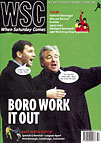 Everton takeover hits difficulties. Neil Wolstenholme reports
Everton takeover hits difficulties. Neil Wolstenholme reports
A year has passed since Bill Kenwright announced his consortium, True Blue Holdings, had reached agreement to acquire Peter Johnson’s 68 per cent stake in Everton for a knockdown £20 million. Joy was unconfined as Everton, inspired by Don Hutchison, routed Sunderland 5-0 on Boxing Day at a sold-out Goodison Park.
Unfortunately, True Blue had barely enough cash to finalise the takeover, so there was to be no quick fix for Everton’s deep-seated financial woes. Initial signs were promising, however. The team maintained a top ten position in the months that followed and stadium options were said to be under review. The local press reported that Everton had ambitious plans for a combined youth academy and training facility and Kenwright fanned speculation of investment from a media company when he spoke of his hopes for a “magnificent deal” on national radio.
Then a late season injury crisis saw Everton finish a disheartening 13th. This set the tone for a miserable close season as John Collins, Hutchison and Nick Barmby all departed, the latter to become arguably the most reviled player in Everton’s history.
A year on, Everton lost at home on Boxing Day to Coventry with 4,500 seats empty. Nor have the fans been able to take comfort from progress off the pitch as the most recent accounts show another large loss and an overdraft above £15 million. The media deal seems like a myth and the youth academy is a rat-infested building site with problems even obtaining planning permission for Portakabins.
Only on the stadium has there been any movement, but doubts continue over the viability of plans for a multi-purpose Arena on Liverpool’s waterfront. The scheme is attracting hostile off-the-record sniping from shadowy (self) interest groups, allegedly within English Partnerships (owner of the land) and Liverpool City Council. Someone certainly seems to want Everton eliminated from contention for the site, even in the face of apparent broad support from residents.
It was against this backdrop that the club shoe-horned its AGM into the gap between Christmas and New Year, ensuring many shareholders were unable to attend and minimising media coverage. The club insists the timing was due to a mix-up with their lawyers, but whatever the reason the result was unsatisfactory. Club chairman Sir Philip Carter ruled out any discussion of the possible media deal (the board even denied they had ever claimed there would be one) and the Kings Dock stadium plans on the grounds of commercial confidentiality.
Walter Smith bore the brunt of questions, tackling them head on and talking with fans after the meeting. By contrast, the board had to be prompted by a shareholder before they responded. Restricted as they were by Sir Philip’s instructions, fans left with more questions than answers, damaging the constructive work done previously by the new board to improve dialogue with (selected) fan and shareholder groups.
Most fans still accept Kenwright’s personal commitment to the club, but doubts are inevitably growing over whether the board will be able to complete the task they have taken on. Fans are looking to them and chief executive Michael Dunford to turn the positive talk into achievement and many would be keen to invest if the chance were offered.
As it stands, Everton go into 2001 with attendances in decline (after steep price rises) and another relegation dogfight looking likely. One year on, the ownership has changed but the problems facing the club remain the same. Optimistic Evertonians are becoming as rare as yetis.
From WSC 168 February 2001. What was happening this month